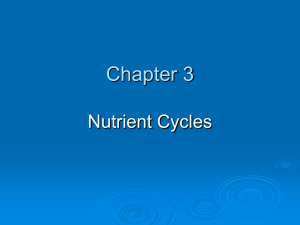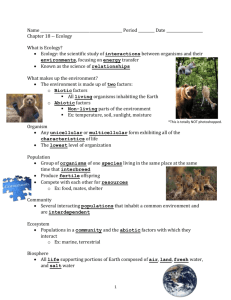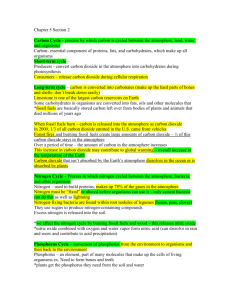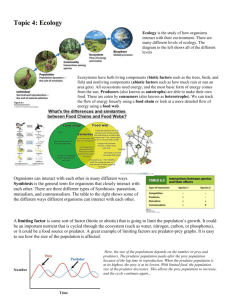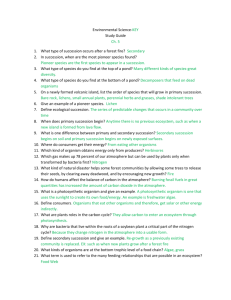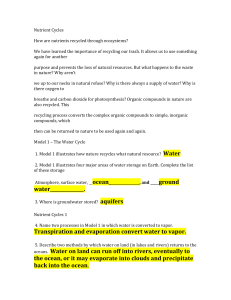Cycles, succession, Food Chains, webs, teacher notes 2015
advertisement
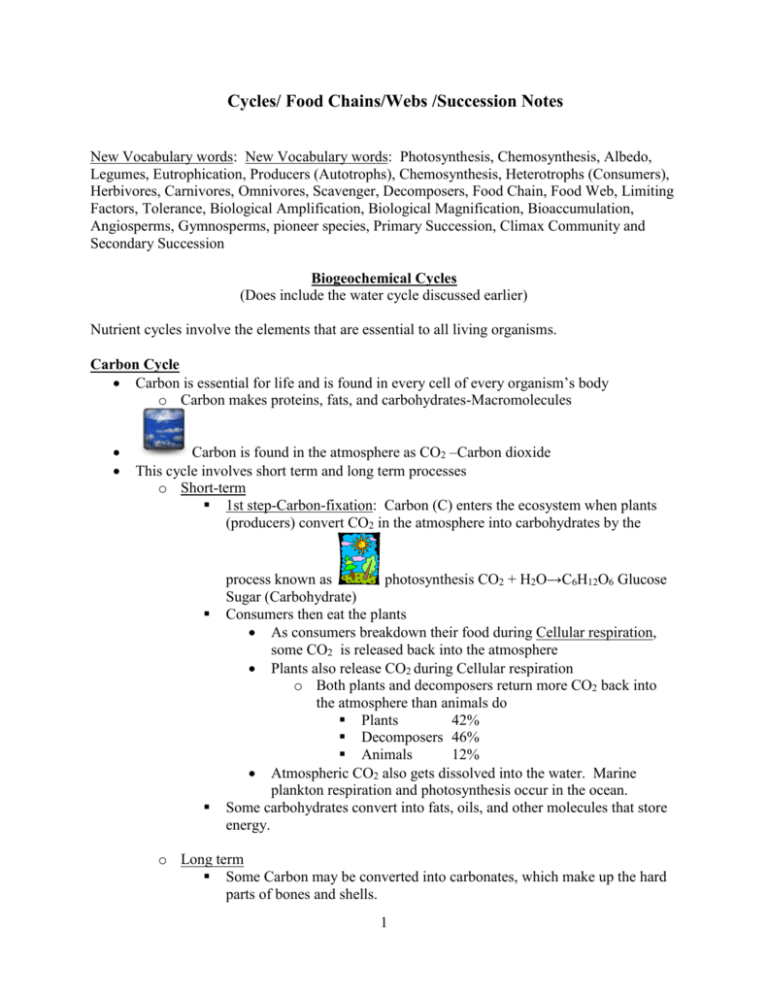
Cycles/ Food Chains/Webs /Succession Notes New Vocabulary words: New Vocabulary words: Photosynthesis, Chemosynthesis, Albedo, Legumes, Eutrophication, Producers (Autotrophs), Chemosynthesis, Heterotrophs (Consumers), Herbivores, Carnivores, Omnivores, Scavenger, Decomposers, Food Chain, Food Web, Limiting Factors, Tolerance, Biological Amplification, Biological Magnification, Bioaccumulation, Angiosperms, Gymnosperms, pioneer species, Primary Succession, Climax Community and Secondary Succession Biogeochemical Cycles (Does include the water cycle discussed earlier) Nutrient cycles involve the elements that are essential to all living organisms. Carbon Cycle Carbon is essential for life and is found in every cell of every organism’s body o Carbon makes proteins, fats, and carbohydrates-Macromolecules Carbon is found in the atmosphere as CO2 –Carbon dioxide This cycle involves short term and long term processes o Short-term 1st step-Carbon-fixation: Carbon (C) enters the ecosystem when plants (producers) convert CO2 in the atmosphere into carbohydrates by the process known as photosynthesis CO2 + H2O→C6H12O6 Glucose Sugar (Carbohydrate) Consumers then eat the plants As consumers breakdown their food during Cellular respiration, some CO2 is released back into the atmosphere Plants also release CO2 during Cellular respiration o Both plants and decomposers return more CO2 back into the atmosphere than animals do Plants 42% Decomposers 46% Animals 12% Atmospheric CO2 also gets dissolved into the water. Marine plankton respiration and photosynthesis occur in the ocean. Some carbohydrates convert into fats, oils, and other molecules that store energy. o Long term Some Carbon may be converted into carbonates, which make up the hard parts of bones and shells. 1 Bones and shells (organic sediment) breakdown slowly (takes millions of years) to form limestone rock. These carbohydrates can be released into the soil or air after the organism dies and form deposits of coal, oil, and natural gas underground-Fossil fuels o The burning of Fossil fuels has lead to the increase in Global Warming The U.S. Department of Energy is using Carbon Sequestration to help solve the global warming problem: They are increasing the storage of CO2 in biomass and soil, enhancing the net oceanic uptake of CO2 from the atmosphere by fertilizing phytoplankton and injecting liquid CO2 into the ocean depths greater than 1000 m, and by pumping CO2 into abandoned mines and petroleum wells. Nitrogen Cycle Organisms cannot exist without amino acids, peptides, and proteins so Nitrogen is a extremely important nutrient. 90 million metric tons of Nitrogen gas is cycled every year: o 90% by nitrogen-fixing bacteria o 10 % by human-produced fertilizers I. Nitrogen gas makes up 78% of the gases in the atmosphere although this form of Nitrogen is only useful to nitrogen-fixed bacteria-So it has to be fixed (altered to be useful)-Nitrogen Fixation o Lightning and Nitrogen-fixed bacteria are the only ways to convert atmospheric Nitrogen into usable Nitrogen The bacteria use sugars in legumes (bacteria live in the nodules of plant roots such as beans, peas, nuts, clover, and alfalfa) and some cyanobacteria produce nitrites (NO2) and nitrates (NO3) which are released into the soil. Plants not rich in Nitrogen absorb it through the soil Animals get Nitrogen by eating plants and herbivore animals. II. Denitrofication- Breaks down the nitrites and nitrates and other waste products III. Ammonia (NH3) is formed IV. After decomposition of the soil takes place Nitrogen escapes and is released into the atmosphere 2 Phosphorus Cycle Phosphorus is the essential part of many molecules that make up the cells –Nucleic acid Macromolecule (element found in DNA and RNA) Phosphorus is rarely found as a gas so is not naturally found in the atmosphere Phosphorus cycle has an inorganic part (nonliving) and organic (living) part to the cycle Plants get Phosphorus in the form of Phosphate (PO4-3) from the soil and water by erosion of rocks leaching out the phosphorus mineral. o The plants absorb (PO4-3) in the soil through their roots Another way plants obtain (PO4-3) is from excreted waste from organisms and from organism that have died and decomposed Animals obtain (PO4-3) from eating plants or herbivore animals If (PO4-3) washes off the land it eventually gets into the oceans. Most (PO4-3) salts won’t dissolve so they settle to the bottom of the ocean floor and accumulate as sediment. Note: Too much Nitrogen and/or Phosphorus causes Eutrophication in Fresh water ecosystems. This problem leads to algal bloom –rapid increase of algae in a source of water o Algal Bloom leads to the depletion of dissolved Oxygen in the water which will cause fish and other aquatic organisms to suffocate and die. Most (PO4-3) in laundry detergents have been banned Nitrogen in fertilizers is still a major problem Sulfur Cycle Sulfur plays a vital role in organisms as it interacts with Nitrogen to make proteins. It is a complicated cycle. Most of the Earth's sulfur is underground in rocks and minerals such as iron sulfides (pyrite) and calcium sulfate (gypsum), coal, oil, and other ores. Weathering and volcanic activity (below -seafloor deep sea vents and above the water surface-volcanoes) are released into the atmosphere and the water as inorganic sulfur. Reduced sulfur (H2S Hydrogen sulfide) to inorganic sulfur (SO2 Sulfur dioxide) to sulfate (SO4-2) due to decomposition of plants and animals. Organisms, especially bacteria, take in sulfur or release it into the atmosphere depending on the amount of oxygen available, the pH level, and the light level. Human activities include mining and burning of fossil fuels in factories and vehicles cause acid rain to develop causing problems. In addition acid rain reduces 3 visibility and absorbs UV light. This causes cloud cover and cools cities and may be reducing the effects of rising CO2 levels. Phytoplankton play an important role by the emissions of dimethylsulfide (DMS), which is oxidized to SO2 and then SO4-2 into the atmosphere. DMS accounts for 50% of all biogenic sulfur emissions. This process increases the Earth's albedo (Sun's reflectivity away from the Earth) and cools the Earth and ocean water temperatures keeping a suitable range for all life. Food Chains and Webs Autotrophs (producers) Producers are organisms that make their own food from inorganic molecules and energy Two types: 1. Photosynthetic-ex. plants and some bacteria like cyanobacteria 2. Chemosynthesis-Giant tube worms and others in Hydrothermic areas of the ocean eat methane and Hydrogen sulfides Heterotrophs (consumers) cannot make their own food and must feed on other organisms Five types: 1. Herbivores feed on plants (ex. grasshoppers, deer, rabbits) 2. Carnivores feed on other heterotrophs (ex. lions) 3. Omnivores feed on both plants and animals (ex. humans, bears) 4. Scavengers feed on dead organisms; have beneficial role in ecosystem (ex. buzzards, insects) 5. Decomposers break down and release nutrients from dead organisms (ex. bacteria) A food chain shows how matter and energy move through an ecosystem. Producer Herbivore Omnivore Example #1: berries mice black bear 1st order Autotroph 1st order Heterotroph 2nd order Heterotroph Example #2: Usually consist of 2, 3, or 4 transfers Each organism represents a trophic level in ecological pyramids There are three types of ecological pyramids: energy, numbers, and biomass 4 Energy pyramids are diagrams that show the relative amounts of energy in different trophic levels in an ecosystem Only 10% is transferred from one level to the next o Autotrophs make up 1st level (100 %) o 1st order heterotroph (2nd level) – feeds on plants (herbivores) (10%) o 2nd order heterotroph (3rd level) – feeds on 1st order heterotroph (1%) o 3rd order heterotroph (4th level) – feeds on 2nd order heterotroph (.1%) o 4th order heterotroph (5th level) -feed on 3rd order heterotroph (0.01%) Some organisms may feed at different levels Example: Biomass is the total amount of organic matter present in a trophic level; is potential food for the next level A food web shows all possible feeding relationships at each trophic level in a community. Example: Succession Communities have limiting factors and go through succession processes that allow Diversity and Stability. Limiting factors-are any biotic or abiotic factors that restrict the survival of an organism May include water, food, predators, temperature/climate Tolerance is an organism’s ability to withstand fluctuations in environmental factors 5 Biological Magnification is the increasing concentration of a pollutant in organism at higher trophic levels in a food web Example: Mercury in fish What is the difference between Biological magnification, Biological Amplification, and Bioaccumulation? (See PPT) Biological Amplification-Toxic pollutants enter the ecosystem that are absorbed or ingested by organisms. Some substances accumulate in organism’s tissue over time. Bioaccumulation -An increase in the concentration of a pollutant in a biological organism compared to its concentration in the environment (It is how pollutants enter a food chain) Biomagnification-Increase in the concentration of a pollutant as it passes from one trophic level to the next (Small amount in environment → Large concentration at top of food chain) Succession-Refers to natural changes that occur in an ecosystem over time in stages Tree cycle: Seed, Sprout, Sapling, Mature Tree, Dead Tree, Rotting Log and then the process starts again Angiosperms produce flowers and protect their seeds inside the fruit A.) Includes many trees along with herbaceous plants and shrubs B.) Usually pollinated by insects or other animals Gymnosperms have naked seeds (instead seeds are produced on cones and pollinated by the wind Two main types of succession: 1.) Primary Succession – colonization of barren land by communities of organisms. After a volcano, the cool lava has no living organisms and no soil. The first inhabitants (pioneer species) are usually lichens but can also include algae, mosses, and ferns. Process: Over time rock weathers and releases minerals Lichen and then moss cover the exposed rock They help to break the rocks down and form soil so plants can take hold Small seeds are carried by animals or blown by wind will take root in the moist bed of vegetation (Seedlings) Small shrubs and plants become established Lastly a healthy community forms that leads to a mature and stable community known as the climax community. 6 2.) Secondary Succession – series of changes that occur after an existing community is disrupted, such as after a forest fire or landscaping occurs. The soil has not been destroyed so cones and other plants open up releasing their seeds (especially after a fire). Small plants and seedling trees form Lastly a healthy community forms that leads to a mature and stable community known as the climax community. 7



